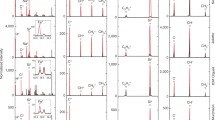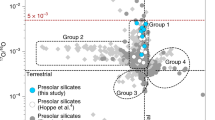Abstract
Interplanetary dust particles (IDPs) collected in the Earth's stratosphere and meteorites are fragments of comets and asteroids. These are ‘primitive’ meteorites in part because they have preserved materials which predate the formation of the Solar System. The most primitive (least altered) meteorites contain a few parts per million of micrometre-sized dust which formed in the atmospheres of giant stars1. Some meteorites2 have elevated D/H and 15N/14N ratios that are attributed to surviving interstellar organic molecules which have probably been strongly diluted and altered by parent-body processes2. Most IDPs are chemically, mineralogically, and texturally primitive in comparison to meteorites3,4. Here I show that H and N isotopic anomalies among fragile ‘cluster’ IDPs are far larger, more common, and less equilibrated than those previously observed in other IDPs or meteorites. In some cases, the D/H ratios that we measure reach the values of interstellar molecules, suggesting that molecular-cloud material has survived intact. These observations indicate that cluster IDPs are the most primitive class of Solar System materials currently available for laboratory analysis.



Similar content being viewed by others
References
Zinner,E. Stellar nucleosynthesis and the isotopic composition of presolar grains from primitive meteorites. Annu. Rev. Earth Planet. Sci. 26, 147–188 (1998).
Messenger,S. & Walker,R. M. in Astrophysical Implications of the Laboratory Study of Presolar Materials (eds Bernatowicz, T. J. & Zinner, E.) 545–564 (AIP Conf. Proc. 402, Am. Inst. Phys, Woodbury, New York, 1998).
Bradley,J. P., Sandford,S. A. & Walker, R. M. in Meteorites and the Early Solar System (eds Kerridge, J. & Matthews, M. S.) 861–895 (Univ. Arizona Press, Tucson, 1987).
Sandford,S. A. The collection and analysis of extraterrestrial dust particles. Fund. Cosmic. Phys. 12, 1–73 (1987).
Flynn,G. J. et al. The volatile content of anhydrous interplanetary dust. Meteoritics 28, 349–350 (1993).
Thomas,K. L. et al. Carbon abundance and silicate mineralogy of anhydrous interplanetary dust particles. Geochim. Cosmochim. Acta 57, 1551–1556 (1993).
McKeegan,K. D., Walker,R. M. & Zinner, E. Ion microprobe isotopic measurements of individual interplanetary dust particles. Geochim. Cosmochim. Acta 49, 1971–1987 (1985).
McKeegan,K. D. Ion microprobe measurements of H, C, O, Mg, and Si isotopic abundances in individual interplanetary dust particles. PhD thesis, Washington Univ., St. Louis (1987).
McKeegan,K. D., Swan,P., Walker,R. M., Wopenka,B. & Zinner,E. Hydrogen isotopic variations in interplanetary dust particles. Lunar Planet Sci. 18, 627– 628 (1987).
Stadermann,F. J. Messung von isotopen- und elementh ufigheiten in einzelnen interplanetaren staubteilchen mittles sekund rionen-massenspektrometrie. PhD thesis, Univ. Heidelberg, Germany (1991).
Zinner,E., Tang,M. & Anders,E. Interstellar SiC in the Murchison and Murray meteorites—isotopic composition of Ne, Xe, Si, C, and N. Geochim. Cosmochim. Acta 53 , 3273–3290 (1989).
Guan,Y., Hofmeister,A., Messenger, S. & Walker,R. M. Two types of deuterium-rich carriers in Renazzo matrix. Lunar Planet. Sci. 29, abstract no. 1760 (1998).
Fraundorf,P., McKeegan,K. D., Sandford, S. A., Swan,P. D. & Walker,R. M. An inventory of particles from stratospheric collectors: extraterrestrial and otherwise. J. Geophys. Res. 87, A403–A408 ( 1982).
Guan,Y., Messenger,S. & Walker, R. M. The spatial distribution of D-enrichments in Renazzo matrix. Lunar Planet. Sci. 28, 489– 490 (1997).
Eberhardt,P., Reber,M., Krankowski,D. & Hodges,R. R. The D/H and 18O/16O ratios in water from comet P/Halley. Astron. Astrophys. 302, 301–316 (1995).
Bockelee-Morvan,D. et al. Deuterated water in comet C/1996 B2 (Kyakutake) and its implications for the origin of comets. Icarus 133, 147 –162 (1998).
Meier,R. et al. Deuterium in comet C/1995 O1 (Hale-Bopp): Detection of DCN. Science 279, 1707–1710 ( 1998).
Alexander,C. M. O'D. et al. The origin of chondritic macromolecular organic matter: A C and N isotope study. Meteor. Planet. Sci. 33, 603–622 (1998).
Keller,L. P., Messenger,S., Miller,M. & Thomas,K. L. Nitrogen speciation in a 15N enriched interplanetary dust particle. Lunar Planet. Sci. 28, abstract no. 1811 ( 1997).
Tielens,A. G. G. M. in Astrophysical Implications of the Laboratory Study of Presolar Materials (eds Bernatowicz, T. J. & Zinner, E.) 523– 544 (AIP conf. Proc. 402, Am. Inst. Phys, Woodbury, New York, 1998).
Langer,W. D., Graedel,T. E., Frerking,M. A. & Armentrout,P. B. Carbon and oxygen isotope fractionation in dense interstellar clouds. Astrophys. J. 277, 581–604 (1984).
Adams,N. G. & Smith,D. N-14N-15 isotope fractionation in the reaction N2H/+/+N2—interstellar significance. Astrophys. J. 247, L123–L125 ( 1981).
Brownlee,D. E. et al. Identification of individual cometary IDPs by thermally stepped He release. Lunar Planet. Sci. 26, 183– 184 (1995).
Messenger,S. & Walker,R. M. Possible association of isotopically anomalous cluster IDPs with comet Schwassmann–Wachmann 3. Lunar Planet. Sci. 29, abstract no. 1906 ( 1998).
Millar,T. J. & Hatchell,J. Chemical models of hot molecular cores. Faraday Disc. 109, 15– 30 (1998).
Acknowledgements
This research was supported by NASA. I thank R. Walker, E. Zinner, L. Nittler, L. Keller, J. Bradley and S. Clemett for useful discussions.
Author information
Authors and Affiliations
Rights and permissions
About this article
Cite this article
Messenger, S. Identification of molecular-cloud material in interplanetary dust particles . Nature 404, 968–971 (2000). https://doi.org/10.1038/35010053
Received:
Accepted:
Issue Date:
DOI: https://doi.org/10.1038/35010053
- Springer Nature Limited
This article is cited by
-
A Comparison of Presolar Isotopic Signatures in Laboratory-Studied Primitive Solar System Materials and Comet 67P/Churyumov-Gerasimenko: New Insights from Light Elements, Halogens, and Noble Gases
Space Science Reviews (2023)
-
Evidence for a significant Kuiper belt dust contribution to the zodiacal cloud
Nature Astronomy (2022)
-
Organic Matter in the Solar System—Implications for Future on-Site and Sample Return Missions
Space Science Reviews (2020)
-
Nitrogen Atmospheres of the Icy Bodies in the Solar System
Space Science Reviews (2020)
-
Interplanetary Dust, Meteoroids, Meteors and Meteorites
Space Science Reviews (2019)





